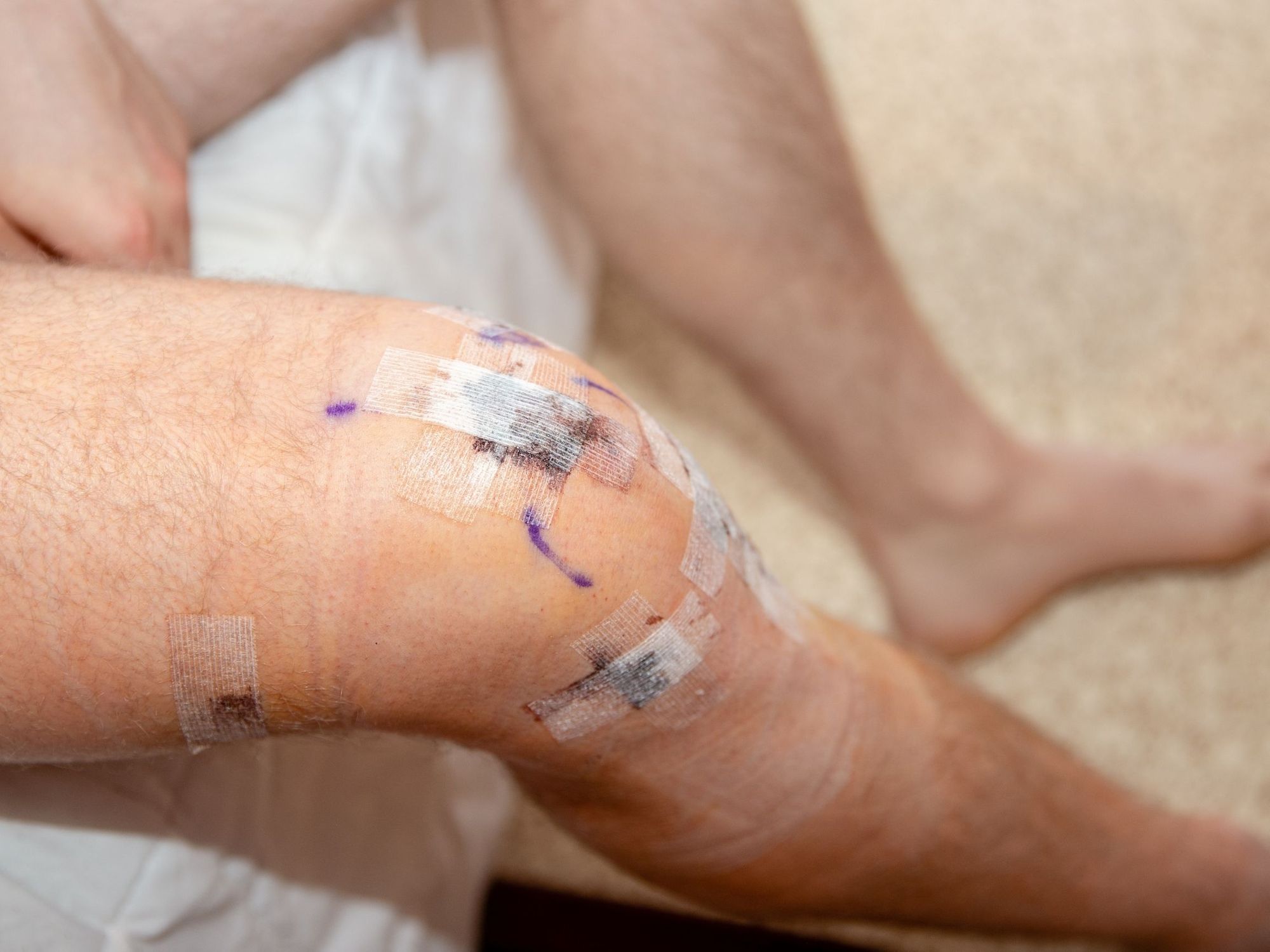Have you torn your ACL and are wondering what is going to happen next? If you have an ACL tear, surgery to reconstruct the ACL can be a recommended option. Your next question may be, where is my new ACL coming from? There are 4 common areas where your new ACL can come from. These are: the quadriceps tendon autograft , the patellar tendon autograft, the hamstring tendon autograft, and a cadaver allograft. Autograft simply means that the tissue or tendon came from your own body. Allograft means that the tissue comes from another person who is an organ donor. Which one of these grafts you receive should always be a collaborative decision with you and your surgeon.
1. Quadriceps Tendon Autograft
The quadriceps is a group of four muscles that run along the front of your thigh. The quadriceps tendon crosses the knee joint and attaches to bone just above your knee cap. A tendon is a structure that connects your muscles to your bones. The quadriceps tendon autograft involves removing a part of the quadriceps tendon and a part of the knee cap bone and attaching it inside the knee joint where the ACL was. The torn ACL gets removed and the quadriceps tendon gets put into the knee joint to replace the torn ACL.
This graft has similar strength to the hamstring and patellar tendon grafts however it is not as strong as these other two.[1] This graft can result in a lower chance of post surgical tendonitis, which is inflammation of the tendon that can result in pain, and you might feel less pain after surgery, especially when trying to knee.[2][3] A quadriceps tendon graft is generally used in young people 25 years or younger, people who have a history of patellar tendon issues (such as patellar tendonosis or patellar tendonitis), people who also tore their MCL, and is more commonly done in females.[2]
2. Patellar Tendon Autograft
The patellar tendon is still part of the quadriceps muscle, but this portion of the tendon attaches to the bone below your knee cap as opposed to above it. The patellar tendon autograft involves removing the middle part of the patellar tendon below the kneecap along with a small portion of the knee cap bone and tibial bone on each end of the tendon. The surgeon removes the torn ACL and puts the new graft into the knee, replacing the torn ACL. This is generally considered to be the gold standard for ACL reconstruction surgeries.[1]
The patellar graft is considered to be one of the strongest ACL grafts along with the hamstring graft.[4] People who have this surgery generally get back to their usual activities and sports in a quicker manner than people who have had other types of grafts.[4] Also, the retear rates have been shown to be lower in people with a patellar tendon autograft.[1] However, some people can feel pain in the front of their knee, especially when trying to kneel, and experience greater difficulty in regaining knee straightening after having this graft done.[1][4] A patellar tendon graft is generally used for most people in their teens, 20’s, 30’s and 40’s.[1]. We've written a great blog about the difference in what you should do if you have a quad tendon graft compared to a patellar tendon graft here!
3. Hamstring Tendon Autograft
The hamstring muscle is a large group of three muscles that run along the back of your thigh. The hamstring tendon crosses the back of the knee joint and attaches to bone just below the back of your knee. The hamstring tendon autograft involves removing part of the hamstring tendon along with a small portion of the back of the shin bone attached to the tendon. The surgeon removes the torn ACL and puts this graft into the knee joint, replacing the torn ACL. The tendon and bone are left to heal and form strong attachment in the knee joint.[5]
This graft is considered to be one of the strongest ACL grafts along with the patellar tendon graft.[1][5]The hamstring graft can result in feeling less pain after surgery, however the healing capacity for this graft is believed to be inferior to the patellar tendon graft.[1] There is also an increased risk of infection after surgery with this graft compared to the other grafts (excluding the cadaver allograft).[1] Hamstring autografts tend to have a higher retear rate than patellar tendon autografts, however, the retear rate is still low in the hamstring autograft and is a viable option for ACL surgery.[1][6]
4. Cadaver Allograft
Cadaver allografts are another surgical option. Cadaver grafts use tissue from another person (an organ donor who is deceased) to replace the ACL. Cadaver grafts are obtained from tissue banks where the tendons are sterilized and processed, and frozen until they are used in surgery.[7] The types of options for donor tissue are similar, and typically surgeons will use the patellar tendon or hamstring tendons.[7] Performing ACL surgery using a cadaver allograft can allow for decreased operative time, smaller incisions, less pain after surgery, and avoid the need to remove a piece of the person's own tissue.[8]
Furthermore, if the graft were to fail, revision surgery could be performed by using the person's own patellar tendon or hamstring tendon.[8] However cadaver grafts do have high revision rates, are prone to graft stretching, have higher rates of failure (not as strong as the other graft types mentioned above), and have an increased risk of transmitting diseases.[1][7] Cadaver grafts are generally used for older adults who are 50 or older. They are generally not used in young people in their teens or twenties or for highly active people such as athletes.[1][7]. We've also written a great blog that answers the question "Is there a difference in what I need to do if I had a cadaver graft compared to a patellar tendon graft for my ACL reconstruction?"
Conclusion
These are four common types of ACL reconstruction grafts and we hope this blog can help you understand the basics of each surgery. This blog should not be used as medical advice but rather to help you understand what each type of ACL graft is. We recommend you always talk to your surgeon to decide your best surgical option prior to ACL surgery.
In our ACL recovery app, Curovate you will find options for patellar tendon, hamstring tendon and non-surgical for 6 months of ACL recovery. If you have had a quadriceps tendon graft or cadaver graft you can select the patellar tendon option as the exercises and rehabilitation are the same for these 3 graft sites. Find the links to our app below.
If you need further customized assistance during your surgery or injury recovery check out our Virtual Physical Therapy page to book your 1-on-1 video session with a physical therapist.
Other recommended blogs
- How does cycling help with my ACL recovery? Is a stationary bike good after ACL surgery? Do I need a stationary bike after ACL surgery
- After ACL surgery, how much help will I need? And help with what?
- Is my ACL graft weaker than my original ACL? Or is my ACL graft stronger than my original ACL?
References
1. Reinold, M. (2020, April 21). What is the Best Graft Choice for ACL Reconstruction? Retrieved December 17, 2020, from https://mikereinold.com/what-is-the-best-graft-choice-for-acl-reconstruction/
2. Sterett, W. (2020, April 14). The Quad Tendon Graft for ACL Reconstruction. Retrieved December 17, 2020, from https://williamsterett.com/blog-dr-william-sterett/quad-tendon-graft-for-acl-reconstruction
3. Pearle, A., Allen, A. (2006). Graft Choices in Ligament Surgery. Clinical Sports Medicine, 515-522. doi:10.1016/b978-032302588-1.50053-1
4. Innovative Sport Medicine. (2018). Patellar Tendon Graft Reconstruction of the ACL. Retrieved December 17, 2020, from https://www.innovativesportmedicine.ca/Injuries-Conditions/Knee/Surgery/Patellar-Tendon-Graft-Reconstruction-of-the-ACL/a~354/article.html#:~:text=The%20standard%20operation%20to%20fix,of%20bone%20on%20each%20end
5. Zein, A. M., Ali, M., Mahmoud, A. Z., Omran, K. (2017). Autogenous Hamstring-Bone Graft Preparation for Anterior Cruciate Ligament Reconstruction. Arthroscopy Techniques, 6(4). doi:10.1016/j.eats.2017.04.011
6. Samuelsen, B. T., Webster, K. E., Johnson, N. R., Hewett, T. E., Krych, A. J. (2017). Hamstring Autograft versus Patellar Tendon Autograft for ACL Reconstruction: Is There a Difference in Graft Failure Rate? A Meta-analysis of 47,613 Patients. Clinical Orthopaedics and Related Research, 475(10), 2459-2468. doi:10.1007/s11999-017-5278-9
7. Cluett, J. (2020, September 17). Using Donor ACL vs. Your Own Tissue. Retrieved December 17, 2020, from https://www.verywellhealth.com/donor-acl-vs-your-own-tissue-4169937
8. Cluett, J. (2020, July 19). Which Type of ACL Graft Should You Choose? Retrieved December 17, 2020, from https://www.verywellhealth.com/acl-surgery-graft-options-2548474
 |
 |
|---|







